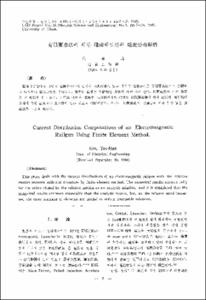Fe-Mn합금계에서 格子結晶構造에 따른 水素脆性의 硏究
- Alternative Title
- A Study on the Hydrogen Embrittlement with Crystal Structures in Fe-Mn alloys
- Abstract
- Fe-Mn합금계에서 나타나는 α相(BCC), γ相(FCC) 및 ε相(HCP)을 이용하여 格子結晶構造가 水素脆性에 미치는 영향을 조사하였다. 전개분해식으로 주입되 水素에 의하여 α相(BCC)은 느린 引張速度下에서 延性이 급격히 감소되었으나, γ相(FCC)과 ε相(HCP)은 약간의 감소만을 보였다. 이는 脆性을 일으키는 臨界水素濃度에 도달하는데 따른 水素原子의 확산속도가, γ相과 ε相에 비하여 α相에서 10?배 정도 더 빠르다는 점과 외부 응력하에서 interstitial site에 있는 水素原子의 불안정성에 기인한 것으로 판단된다.
Using the Fe-Mn alloys with three different crystal structures; α phase(BCC), γphase(FCC) and εphase(HCP), the effect of cathodically-charged hydrogen on the mechanical properties has been studied. The experimental results show that BCC (α) is susceptible to hydrogen embrittlement, while HCP (ε) and FCC (γ) are relatively not. Diffusion of hydrogen atoms may be required to build up the critical concentration for the embrittlement. Hydrogen diffusion rates in FCC(γ) and HCP(ε) are about four order of magnitude slower than that in BCC(α). And the diffusible hydrogen atoms at the octahedral interstitial sites of FCC and HCP structures could be more stable to locate than at the tetrahedral interstitial sites of BCC structure.
Therefore, one may hypothesize that FCC(γ) and HCP(ε) are relatively immune to hydrogen embrittlement due to their slow hydrogen diffusion rate and their stability at the interstitial sites.
Using the Fe-Mn alloys with three different crystal structures; α phase(BCC), γphase(FCC) and εphase(HCP), the effect of cathodically-charged hydrogen on the mechanical properties has been studied. The experimental results show that BCC (α) is susceptible to hydrogen embrittlement, while HCP (ε) and FCC (γ) are relatively not. Diffusion of hydrogen atoms may be required to build up the critical concentration for the embrittlement. Hydrogen diffusion rates in FCC(γ) and HCP(ε) are about four order of magnitude slower than that in BCC(α). And the diffusible hydrogen atoms at the octahedral interstitial sites of FCC and HCP structures could be more stable to locate than at the tetrahedral interstitial sites of BCC structure.
Therefore, one may hypothesize that FCC(γ) and HCP(ε) are relatively immune to hydrogen embrittlement due to their slow hydrogen diffusion rate and their stability at the interstitial sites.
- Issued Date
- 1982
- Type
- Research Laboratory
- Alternative Author(s)
- Chun,Hui Gon; Nam,Soo Woo
- Publisher
- 연구논문집
- Language
- kor
- Rights
- 울산대학교 저작물은 저작권에 의해 보호받습니다.
- Citation Volume
- 13
- Citation Number
- 2
- Citation Start Page
- 383
- Citation End Page
- 390
- Appears in Collections:
- Research Laboratory > University of Ulsan Report
- 파일 목록
-
-
Download
 000002024579.pdf
기타 데이터 / 250.62 kB / Adobe PDF
000002024579.pdf
기타 데이터 / 250.62 kB / Adobe PDF
-
Items in Repository are protected by copyright, with all rights reserved, unless otherwise indicated.